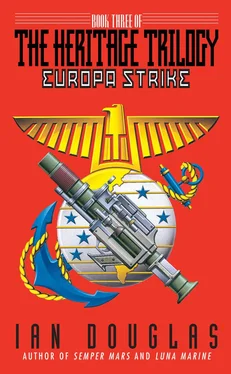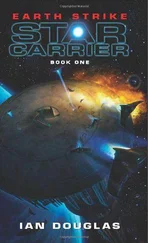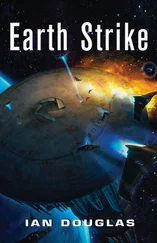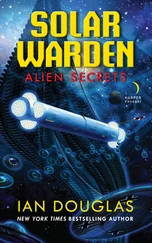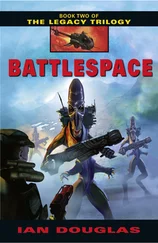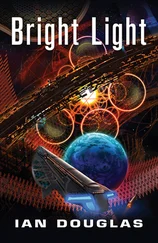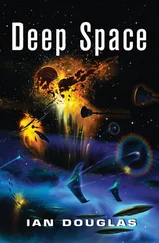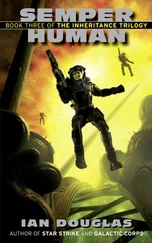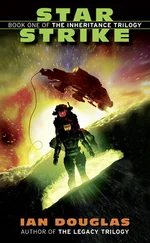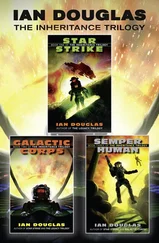The Roosey carried two bugs, plus four similar craft used strictly for transporting cargo. The Ops Plan called for using both bugs to ferry all of Bravo—eighty-one Marines and six SEALs—to the CWS Cadmus Research Station on Europa. They would then refuel and rendezvous with the Roosey to take aboard the headquarters and support platoons in the next run, and finally return a third time for Charlie Company. The cargo landers would be shuttling back and forth between the surface and orbit for the next two days, bringing down not only the four Manta submersibles and all of the Marines’ supplies, but a load of consumables for Cadmus Station as well.
Cadmus Station consisted of twenty-five men and women from six nations. Most had been on Europa since the station had been established over a year before, and they were totally dependent on occasional ships from Earth for food and spare parts.
Water, at least, they had plenty of. Europa’s surface was a sheath of solid water ice, enclosing an ocean fifty to one hundred kilometers deep—five to ten times deeper than the deepest ocean abyss on Earth.
“Eight seconds to release,” Lieutenant Walthers said from the bug’s command deck. “Hang onto your lunches back there! And three…and two…and one…release!”
There was a slight jar as the mechanical grapples connecting the bug to the Roosey’s spine swung open, and a half-second burst from the dorsal thrusters set them in motion. The admonition to the Marines to retain their lunches seemed uncalled for…until the thrusters fired again and the bug rolled sharply to port.
Through his narrow window view on the starboard side, Jeff saw the Roosevelt swing ponderously into view, all light and midnight-dark, a long, slender rail with bulbous water tanks attached along her entire length, her habs like four sledgehammers attached at the handles still slowly rotating just aft of the forward tank. During acceleration, the rotation was halted and the habs folded back against the ship’s spine, preserving the up-down conventions of each deck. Once the Roosevelt had entered orbit around Europa, however, the habs had redeployed while the bugs were made ready for the descent. Heat radiators spread astern like enormous, squared-off tailfeathers. Getting rid of excess heat in vacuum was always a major spacecraft design problem, and the antimatter reaction of the drive created a lot of excess heat.
Those last twelve hours that the drive had been running, with the Marines on board stewing in their own overheated juices, had been a nightmare.
The bug continued its roll, dragging the Roosevelt out of Jeff’s line of sight. He was hoping for a glimpse of Jupiter, but the next thing he saw was a vast arc of darkness swallowing the stars one by one. The lights illuminating the bug’s passenger deck were dim and amber, but still bright enough that he couldn’t see any detail in the night outside the craft. They were falling over Europa’s night side.
He’d seen Europa during their final approach, as well as during training sims, of course. The moon looked like nothing so much as a straw-colored marble heavily crisscrossed by long, straight lines of a deeper, reddish color.
The bug’s main engines fired their deorbit burn, and Jeff’s stomach lurched at the sudden resumption of acceleration, a huge hand clamping down across his chest. Then, just as suddenly, the hand was gone and he was weightless again.
But the Roosevelt was falling away above and ahead, continuing to orbit the moon while the bug descended rapidly toward the surface, following a long, descending curve that would take them halfway around the moon. He thought he could make out something of the Europan surface now, irregular patches less black than their surroundings, glossy smooth areas, perhaps, illuminated by starlight. Then, quite suddenly, black gave way to darkest gray, lightening swiftly as the far horizon, still curved, took fire from the fast-rising Sun.
The bug swept across the terminator, passing from night into day. Jeff blinked, then adjusted his helmet’s polarization. The surface now was ice, reflecting sun-dazzle in brilliant white patches interspersed with tan and ocher-colored regions. Jeff stared at the surface turning below, fascinated, no matter how many times he’d seen computer simulations and vids already. The surface looked remarkably like old, early twentieth-century notions of the planet Mars, complete with long, straight canals, called lineae. A kind of plate tectonics worked here; Europa’s core, molten from tidal flexing in the tug-of-war between Jupiter and the other major Jovian satellites, kept Europa’s ocean liquid. The upper few kilometers of that ocean, however, were frozen. As the tides continued to stretch the tiny world, the icecap cracked, refroze, and cracked again, until it looked like a frosted crystal ball with a surface crazed by thousands of straight-line cracks and fissures. There were almost no craters that he could see. Here and there, however, he could make out large, circular features, the maculae, which looked like spots on an iced-over pond in early spring where someone had chucked a rock through, and the resulting hole had been closed over by thin skim ice. And that, as a matter of cold fact, was almost certainly a precise analogy. Traditional craters couldn’t last on that landscape of constantly resculpted ice and intense radiation bombardment for more than a few hundred thousand years, if that. Once in a while, though, a rock big enough to leave a lasting impression must impact with the surface and leave its footprint, even if for only a short time as planets and moons measured such things.
The icy surface was remarkably flat. No mountains. No cliffs. This close, he could see that the major, straight cracks were supplemented by myriad smaller ones, until the reddish lines resembled a cascade of long, red hair matted across the moon’s pale surface.
The image of red hair made him think of Carsyn, back in California. That homesick thought jarred, superimposed as it was on the alien majesty below. He’d been thinking about her a lot during the voyage out from Earth.
He’d promised to give her an answer when he returned, at the end of this deployment. Yeah…six months on this ice box ought to give him the time he needed to make a decision like that.
The bug’s engines fired again, a savage, bucking kick through the hard seat upright at his back. The curve of the horizon was definitely flatter now. It was impossible to estimate their altitude by eye, however. The landscape below was simply too alien, too far beyond common human experience and lacking in any recognizable features, for him to make even a guess. In places, the terrain was jumbled and broken; elsewhere it was absolutely flat. They could have been ten kilometers up, or looking at a snow field from an altitude of two meters.
On closer inspection, the linea turned out to be less like the canals of Percival Lowell’s Mars than they were arctic pressure ridges. Those dark-colored lines were in fact elevations in the landscape, rising a hundred meters or so above the surrounding terrain. The dark color was partly the effect of sunlight reflecting from slopes instead of flats, but also seemed to be the result of coloring of some sort contaminating the ice. Current theory held that as separate plates of the Europan ice cap ground together or cracked apart, water upwelled from beneath, bringing with it a concentrated soup of organic molecules that were frozen in the slow-rising pressure ridges. Europa’s global sea was rich in sulfur, iron, and iron-sulfur compounds; the life forms discovered there so far metabolized sulfur, analogues of the deep-ocean life discovered over eighty years before around some of Earth’s sea-bottom volcanic vents.
Before much longer, it became apparent that Europa’s billiard-ball flatness was largely an illusion. There were vast, smooth-ice plains, but most of the surface was chaotic, a blind jumble of blocks and chunks and fragments repeatedly fragmented, mashed together, refrozen, then broken again. The surface, Jeff thought, looked like an endless sea of icebergs packed together into a solid mass. His Marine training looked at the tangle sweeping past below, and decided that combat in that labyrinthine tangle would be…a challenge.
Читать дальше
